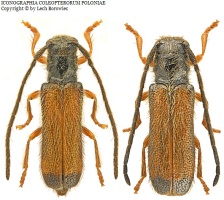Підтримуємо Вільну Україну
 We Support Free Ukraine
We Support Free Ukraine

Biodiversity Map
Taxa

Tetrops — subordinate taxa:
Taxon count: 1
-
Arthropodaphylum
Click to switch
to select orders
and filters > -
Hexapodasubphylum
Click to switch
to select orders
and filters > -
Insectaclass
Click to switch
to select orders
and filters > -
Coleopteraorder
Click to set
as the main taxon
and as a base
← of the left panel > -
Polyphagasuborder
Click to set
as the main taxon
and as a base
← of the left panel > -
Cucujiformiaseries
Click to set
as the main taxon
and as a base
← of the left panel > -
Chrysomeloideasuperfamily
Click to set
as the main taxon
and as a base
← of the left panel > -
Cerambycidaefamily
Click to set
as the main taxon
and as a base
← of the left panel > -
Lamiinaesubfamily
Click to set
as the main taxon
and as a base
← of the left panel > -
Tetropinitribe
Click to set
as the main taxon
and as a base
← of the left panel > -
Tetropsgenus
Click to set
as the main taxon
and as a base
← of the left panel > -
Tetropssubgenus
Click to set
as the main taxon
and as a base
← of the left panel > -
Tetrops starkiispecies
Click to set
as the main taxon
and as a base
← of the left panel >
PL
YES
name status: valid name
BioMap ID: 1052892
taxon code: 4212
taxonomy checked: YES
Data on distribution in Poland

Statistics
- Records: 111
- Publications: 21
- Collections: 16
- Publication authors: 28
- Illustrations (iconography): 1
- Photos (specimen/observation): lacking
Taxon description
Gatunek o niedostatecznie poznanym rozsiedleniu, gdyż ze względu na duże podobieństwo nie odróżniany od pospolitego T. praeusta (L.). Notowany z nielicznych stanowisk w południowej i środkowej części Europy oraz z Norwegii, Szwecji, Kaukazu i Zakaukazia. W Polsce chrząszcz mało znany, wykazywany z nielicznych stanowisk w pięciu tylko krainach w zachodniej i południowo-zachodniej części kraju. Bionomia tego gatunku jest słabo poznana. Dotychczas nie są znane niższe postacie rozwojowe. Imagines łowiono głównie w maju i czerwcu, na ogół rzadko i sporadycznie, tylko niekiedy w większej liczbie okazów. W latach 1959-1968 M. Lessaer znalazł na jednym stanowisku około 70 okazów. Chrząszcze występowały na spodniej stronie liści na nisko rosnących gałęziach jesionu wyniosłego — Fraxinus excelsior L., a poławiano je w godzinach przed- i popołudniowych w dni słoneczne i bezwietrzne (Śliwiński i Lessaer 1970). Według danych z piśmiennictwa rozwój larwalny odbywa w jesionach, rzadziej w dębach, ale przypuszcza się, że również w innych drzewach liściastych.
Illustrations
... browse
 Tetrops
Tetropsstarkii
starkii
External data sources
- Ostatnie rekordy
-
1141534
 ⊡
⊡ Cerambycidae: Tetrops starkii starkii, PL, Nizina Wielkopolsko-Kujawska, Żmigródek ad Żmigród, UTM XT30, 2009, leg. R. Plewa
Cerambycidae: Tetrops starkii starkii, PL, Nizina Wielkopolsko-Kujawska, Żmigródek ad Żmigród, UTM XT30, 2009, leg. R. Plewa -
1110428
 ⊡
⊡ Cerambycidae: Tetrops starkii starkii, CZ, Uhersko, UTM WR73, 2004, leg. V. Hron
Cerambycidae: Tetrops starkii starkii, CZ, Uhersko, UTM WR73, 2004, leg. V. Hron -
1091819
 ⊡
⊡ Cerambycidae: Tetrops starkii starkii, PL, Wzgórza Trzebnickie, Borowa Oleśnicka ad Oleśnica, UTM XS97, 1992, leg. R. Królik
Cerambycidae: Tetrops starkii starkii, PL, Wzgórza Trzebnickie, Borowa Oleśnicka ad Oleśnica, UTM XS97, 1992, leg. R. Królik -
1059975
 ×
× Cerambycidae: Tetrops starkii starkii, CZ, Uhersko, 2004, leg. V. Hron
Cerambycidae: Tetrops starkii starkii, CZ, Uhersko, 2004, leg. V. Hron -
1059974
 ×
× Cerambycidae: Tetrops starkii starkii, CZ, Uhersko, 2004, leg. V. Hron
Cerambycidae: Tetrops starkii starkii, CZ, Uhersko, 2004, leg. V. Hron -
1059973
 ×
× Cerambycidae: Tetrops starkii starkii, CZ, Uhersko, 2004, leg. V. Hron
Cerambycidae: Tetrops starkii starkii, CZ, Uhersko, 2004, leg. V. Hron -
768359
 ⊡
⊡ Cerambycidae: Tetrops starkii starkii, PL, Wyżyna Małopolska, Puszcza Kozienicka, Kozłów, UTM EC10, 2003, leg. M. Miłkowski (Miłkowski 2004)
Cerambycidae: Tetrops starkii starkii, PL, Wyżyna Małopolska, Puszcza Kozienicka, Kozłów, UTM EC10, 2003, leg. M. Miłkowski (Miłkowski 2004) -
768358
 ⊡
⊡ Cerambycidae: Tetrops starkii starkii, PL, Wyżyna Małopolska, Puszcza Kozienicka, Kozłów, UTM EC10, 2003, leg. M. Miłkowski (Miłkowski 2004)
Cerambycidae: Tetrops starkii starkii, PL, Wyżyna Małopolska, Puszcza Kozienicka, Kozłów, UTM EC10, 2003, leg. M. Miłkowski (Miłkowski 2004) -
766995
 ⊡
⊡ Cerambycidae: Tetrops starkii starkii, PL, Nizina Mazowiecka, Puszcza Kozienicka, Brzóza, UTM EC21, 2004, leg. M. Miłkowski (Miłkowski 2004)
Cerambycidae: Tetrops starkii starkii, PL, Nizina Mazowiecka, Puszcza Kozienicka, Brzóza, UTM EC21, 2004, leg. M. Miłkowski (Miłkowski 2004) -
766994
 ⊡
⊡ Cerambycidae: Tetrops starkii starkii, PL, Nizina Mazowiecka, Puszcza Kozienicka, Brzóza, UTM EC21, 2004, leg. M. Miłkowski (Miłkowski 2004)
Cerambycidae: Tetrops starkii starkii, PL, Nizina Mazowiecka, Puszcza Kozienicka, Brzóza, UTM EC21, 2004, leg. M. Miłkowski (Miłkowski 2004) - ... more
- Powiązane publikacje
-
Tatur-Dytkowski J., Górski P., Stępień S. 2020. Nowe dane o interesujących kózkowatych Warszawy (Coleoptera: Cerambycidae). Wiad. Entomol., 39(1)(online 3A):11-16.
 Show records
Show records -
Gutowski J.M., Sućko K., Borowski J., Kubisz D., Mazur M.A., Melke A., Mokrzycki T., Plewa R., Żmihorski M. 2020b. Post-fire beetle succession in biodiversity hotspot: Białowieża Primeval Forest. For. Ecol. Manage., 461:117893.
 Show records
Show records -
Szczepański W., Szczepański W.T. 2019. Nowe stanowiska wybranych gatunków z rodziny kózkowatych (Coleoptera: Cerambycidae) w Polsce południowo-zachodniej. Acta Ent. Siles., 27(online 012):1-11.
 Show records
Show records -
Szczepański W.T., Herczek A. 2019. Kózkowate (Coleoptera: Cerambycidae) wybranych obszarów Natura 2000 w dolinie górnej Odry. Monographs of the Upper Silesian Museum, 11.
 Show records
Show records -
Żurawlew P., Melke A. 2018. Kózkowate (Coleoptera: Cerambycidae) powiatu pleszewskiego (Nizina wielkopolsko–kujawska). Przegl. Przyr., 29(2):80-97.
 Show records
Show records - ... more




